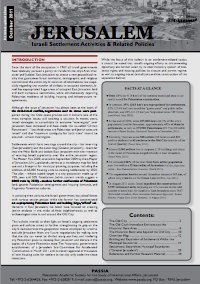Jerusalem Israeli Settlement Activities & Related Policies
Overview
Since the start of the occupation in 1967, all Israeli governments have zealously pursued a policy to transform the city’s Arab character and ‘Judaize’ East Jerusalem to create a new geopolitical reality that guarantees Israeli territorial, demographic, and religious control over the entire city. In violation of international law (especially regarding the transfer of civilians in occupied territory), Israel has expropriated huge areas of occupied East Jerusalem land and built numerous settlements, while simultaneously depriving Palestinian residents of building, housing, and infrastructure requirements.
Although the issue of Jerusalem has always been at the heart of the Arab-Israeli conflict, negotiations over its status were postponed during the Oslo peace process and it remains one of the most complex issues still awaiting a solution. In recent years, Israeli strategies to consolidate its exclusive “sovereignty” over Jerusalem have increased and have made the so-called ‘Clinton Parameters’ - “that Arab areas are Palestinian and Jewish ones are Israeli” and that “maximum contiguity for both sides” should be ensured - almost meaningless. Settlements which form two rings around the city - the inner ring (East Jerusalem) and the outer ring (Greater Jerusalem) - reach far into the West Bank and isolate East Jerusalem with the intention of securing Israeli superiority over the entire Jerusalem region. The Master Plan 2000, unveiled in September 2004 by then-Mayor of Jerusalem, Uri Lupolianski, serves as a mandatory map for land use and a blueprint for municipal planning purposes, including the addition of 65,000 housing units to existing settlements by 2020. The plan – whose stated target is a city population made up of 70% Jews and 30% Palestinians (while current trends suggest a 60:40 ratio by 2020) - involves further confiscation of Palestinian land, ignores Palestinian development and housing demands, and fragments Palestinian suburbs. In pursuing their policies, the Israeli government has joined forces with various settler groups: while the former has concentrated on expropriating Palestinian land and building large, ‘official’ settlements in East Jerusalem, the latter have focused on creating Jewish enclaves in the midst of Arab neighborhoods, as well as archaeological sites in and around the Old City. This bulletin intends to shed light on Israel’s ongoing settlement plans and policies aimed at further strengthening its grip on the city. It demonstrates the geopolitical means employed by Israel to exclude Jerusalem from any future negotiations by making sure that the city can never be divided along any lines, and hindering any Palestinian plans to develop East Jerusalem and declare it the capital of a future Palestinian state. The Netanyahu government’s establishment of a Jerusalem Sub-Committee for Accelerated Construction in March 2011 and its recent approval of thousands of new housing units for settlers in the city only underline these intentions. While the focus of this bulletin is on settlement-related topics, it should be noted that Israel’s ongoing efforts at circumventing diplomacy are further aided by its discriminatory system of residency rights and housing policies, its closure and permit regime, as well as ongoing house demolitions and the construction of theseparation barrier.

